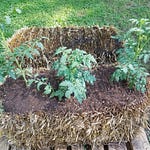We are all taught in school that plants do this thing called “photosynthesis”; that it involves light; and, that by virtue of photosynthesis, plants suck in carbon dioxide and breathe out oxygen and convert the sun to energy they can store and use as needed... but I don’t think we fully grasp how amazing that is; and as gardeners, I really don’t think we give it enough thought when designing and planning our gardens.
Everything Needs Energy
Every living thing on the planet needs energy to perform the activities that allow it to survive and perpetuate itself. Animals get their energy from other animals, or from plants. Plants get their energy from the sun.

This simple fact is amazing when you consider that the finest minds in the world are all trying to find ways to generate energy without the use of fossil fuels, while a simple blade of grass does this effortlessly.
Consider the human being with it’s powerful mind, it’s marvelous hands, and it’s ability to use these gifts to survive in a wide range of environments. We are quite remarkable indeed – but even on our best day we can’t make a meal of the sun. Plants are remarkable in their ability to do this, and thankfully, they’ve been doing this for a very long time.
Sun + Plants = Life
Lets go way back in geological time to Earth’s first atmosphere (over 4 billion years ago), which was, to the best of our understanding, initially comprised of hydrogen and helium. This didn’t last long because the earth was so hot, and those two elements move so fast, that they simply bled off into space. Not to worry. The earth’s crust at this point in time was still forming, and there were volcanoes everywhere spewing water (H2O) in the form of steam, carbon dioxide (CO2), ammonia (NH3), and other nasty stuff into the sky. This mess became earth’s second atmosphere. Not very inviting, but it was a start. Over time, with cooling and centuries of rain, all that steam became our oceans. Eventually, over time, the carbon dioxide dissolved into the oceans and the ammonium (NH3) was broken down by the sun to be hydrogen and nitrogen. The nitrogen stayed in the atmosphere and the hydrogen again went off into space. During this process another thing was happening in the world’s oceans: very simple forms of bacterial life developed – and these creatures did something amazing – they lived on sunlight and carbon dioxide and discharged oxygen (O2) into the atmosphere. This was the beginning of the atmosphere we have now, which over time, with the proliferation of other photosynthetic forms of life on the planet, came to be the luxurious and rare combination of 78% nitrogen (N2), 21% Oxygen (O2), 0.9% argon and 0.1% other stuff that we all breathe today.
The next time you take a breath, take a minute to thank photosynthesis (https://www.peakpx.com/en/hd-wallpaper-desktop-ngbzf)
This is wonderful, but our atmosphere needs constant maintenance – for you see, oxygen (O2) is not stable. It is prone to reacting with other elements – like carbon for instance – so it constantly needs to be freed from those chemical bonds and re-introduced to the atmosphere as O2 if we humans and all the other complex organisms on the planet are going to continue to survive. Thankfully, plants do this for us free of charge, and then we eat them, or build houses out of them, or use them to make campfires. What a great deal for us!
Plants are Energy Machines!
Not amazed yet? Well, it’s also the case that plants transfer the energy that they gather from the sun to the soil. YES – YOU HEARD THAT RIGHT! Not only can plants use the sun’s energy to make stems, leaves, and tasty stuff like tomatoes, but they also send energy into the soil in the form of various excretions called root “exudates”. This activity may seem like a waste of energy, but it’s not. Plants do this to affect changes in the soil that make it more favourable to them. By means of root exudates, plants change the soil near their roots. This area of the soil is called the “rhizosphere”. Think of the exudates like a kind of “special juice” made by each plant to protect itself from things it does not want near its roots, but also to draw in things that it does want near its roots, and, to adjust the pH of the rhizosphere to more favourable levels.
There’s more going on here than meets the eye! This beet is using some of its energy to change the soil. (https://pixabay.com/photos/beet-root-beet-red-vegetable-798097/)
Your Plants Need Sun
I am going a little overboard with the science here, and I apologize for that, but I am trying to stress the fact that none of this happens without the right amount of energy from the sun. I think we often trick ourselves into thinking that plants get what they need from the ground. Think of how much thought we put into contemplating soil health, soil amendments, soil composition, and so on. All of these things are important, but they get you nowhere if you do not have enough sun.
Imagine a person with great bones, the perfect balance of vitamins, the optimal amount of water – but no caloric intake. Such a person will not last long; and a new born baby under such conditions has no chance. Your tiny seedlings are very analogous to new born babies. If they do not get enough sun they will not have the energy they need to grow big and strong. Different plants need different amount of sunlight. If your plants get the right amount of sun you will get fantastic results, and the plants may even be able to overcome less than ideal soil conditions by virtue of their ability to invest some of the energy they are capturing from the sun into the soil to make it more suitable to their needs.
Final Thoughts
It’s important to understand that everything in your garden runs on energy, and that energy transfer in a garden starts with the sun – goes to your plants– then goes to everything else, including you. People that are building new gardens often come to me with many questions – but it’s very rare that they ask if they have positioned their garden in the right place to get enough sun. Given that sunlight is the only thing we can’t compensate for as gardeners (we can’t add more of it if we don’t have enough), and how crucial it is for success, it should be top of mind for any garden plan.
















Share this post